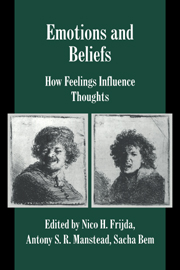Book contents
- Frontmatter
- Contents
- Contributors
- 1 The influence of emotions on beliefs
- 2 Feeling is believing: Some affective influences on belief
- 3 Beliefs through emotions
- 4 The sentiments and beliefs of distributed cognition
- 5 Feeling is believing? The role of processing strategies in mediating affective influences on beliefs
- 6 The formation of beliefs at the interface of affective and cognitive processes
- 7 Anxiety, cognitive biases, and beliefs
- 8 A cognitive dissonance theory perspective on the role of emotion in the maintenance and change of beliefs and attitudes
- 9 Relationship beliefs and emotion: Reciprocal effects
- Index of authors
- Index of subjects
- Studies in Emotion and Social Interaction
9 - Relationship beliefs and emotion: Reciprocal effects
Published online by Cambridge University Press: 10 March 2010
- Frontmatter
- Contents
- Contributors
- 1 The influence of emotions on beliefs
- 2 Feeling is believing: Some affective influences on belief
- 3 Beliefs through emotions
- 4 The sentiments and beliefs of distributed cognition
- 5 Feeling is believing? The role of processing strategies in mediating affective influences on beliefs
- 6 The formation of beliefs at the interface of affective and cognitive processes
- 7 Anxiety, cognitive biases, and beliefs
- 8 A cognitive dissonance theory perspective on the role of emotion in the maintenance and change of beliefs and attitudes
- 9 Relationship beliefs and emotion: Reciprocal effects
- Index of authors
- Index of subjects
- Studies in Emotion and Social Interaction
Summary
Beliefs and emotions are tied together in many ways. In recent years the connections between beliefs and emotions receiving the most attention are those existing within a single person. That is, many researchers have asked just how and why a person's beliefs influence his or her own affective experiences; others have asked just how and why a person's affective states influence his or her own beliefs. Such work is well represented in the present volume. This chapter, however, is written from a different perspective – an interpersonal rather than an intrapersonal perspective- something that, as Ekman and Davidson (1994) have noted, has been given “short shrift” among psychologists interested in emotion.2 We address two broad questions: First, how do people's beliefs about their relationships with others influence their expressions of emotions to those others? Second, how do experiences and expressions of emotion influence beliefs about relationships?
In answering these questions we argue for the idea that the structure of social relationships has important implications for understanding the experience, expression and interpretation of emotions. In so doing, we follow in the tradition of others who have noted the importance of understanding social structure for understanding emotion. This tradition includes researchers who have emphasized how status and power influence expressions of emotion (Kemper, 1978, 1993), those who emphasize how gender roles influence the expression of emotion (Brody, 1985; Brody & Hall, 1993; Timmers, Fischer, & Manstead, 1998), and Hochschild who has argued that the nature of one's job may require “emotion work” (Hochschild, 1975,1979,1990).
- Type
- Chapter
- Information
- Emotions and BeliefsHow Feelings Influence Thoughts, pp. 212 - 240Publisher: Cambridge University PressPrint publication year: 2000
- 24
- Cited by



